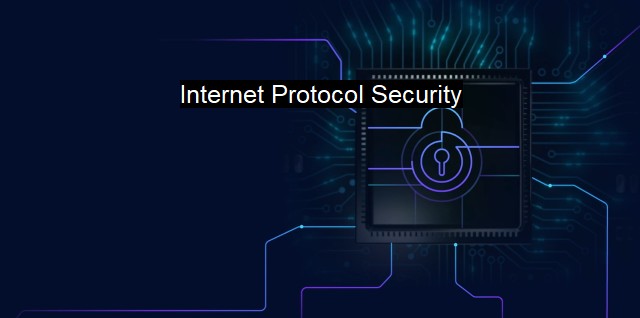What is Internet Protocol Security?
The Importance of Internet Protocol Security (IPsec) in Cybersecurity: Architecture, Functionality, and Benefits for Users and Organizations
Internet Protocol Security, commonly known as IPsec, is a comprehensive suite of protocols developed by the Internet Engineering Task Force (IETF) to provide privacy, authentication, and confidentiality to data communications over Internet Protocol (IP) networks. It plays a crucial role in the realm of cybersecurity and antivirus measures, providing a protective shield to the communication system from a broad range of threats.In an era where increasingly sophisticated cyber attackers can expose and manipulate sensitive information, the importance of having a robust method to transmit data securely cannot be underemphasized. Exactly where IPsec comes into play. By creating an encrypted tunnel for the information packets to safely traverse the vast landscape of the internet, it guards critical data from prying eyes, ensuring the information's integrity and confidentiality during transmission.
IPsec operates directly on the network layer of the OSI model, providing protection to all applications using IP, thereby eliminating the need for application-by-application defensive measures. It assists software or protocol developers enormously, as it allows them to create applications without having to consider all potential security threats.
IPsec offers two different modes of operation: Tunnel mode and Transport mode. In Tunnel mode, the entire IP packet is protected by being concealed within an 'outer' IP packet. This method is employed typically when protecting data between two separate networks through a gateway or router. Conversely, Transport mode only protects the payload of the IP packet rather than the entire packet, while leaving IP header untouched. It's widely used for end-to-end communication, such as between a client and server.
The protective mechanisms within IPsec are encoded into two key protocols: Authentication Header (AH) and Encapsulating Security Payload (ESP). AH provides data integrity, data origin authentication, and optional protection against replays, but it lacks confidentiality measures, i.e., it does not encrypt data. On the other hand, ESP provides all of those very protections, along with confidentiality by encrypting the payload and creating secure connections between IP networks, hence, it is more commonly used than AH.
IPsec also supports Virtual Private Network (VPN) creation, providing individuals or organizations with a secure means of accessing a private network over an inherently insecure public internet. By creating a secure, encrypted ‘tunnel’, IPsec prevents unauthorized interception or intrusion during the transfer of data between the user’s personal device and the private network.
Despite the aforementioned protection, IPsec is not entirely immune to vulnerabilities. Challenges remain particularly concerning the authenticity of the parties involved in an IPsec transaction. By exploiting weakly implemented or maintained key management practices, a malicious actor could masquerade as a valid user to gain unpermitted access to IPsec-protected communications.
Regularly updating cybersecurity measures can help minimize these threats, such as patching software vulnerabilities swiftly, replacing default passwords and username information with strong, unique codes, and utilizing multifactor authentication.
As rich Internet connectivity continues to become an integral part of our everyday lives, the function of frameworks like IPsec will increasingly pivot towards combatting ever-evolving cyber threats. Through its encryption and authentication complex, this protocol can secure vital data and ensure that it reaches its desired destination without being tampered with. Although development can ensure its security continuously adapts to growing threats, organizations should always complement this protection with sound security practices for optimal effectiveness.

Internet Protocol Security FAQs
What is Internet Protocol Security (IPsec)?
Internet Protocol Security (IPsec) is a protocol suite that secures IP communication by authenticating and encrypting each IP packet in a data stream. It offers end-to-end security by encrypting data at the sending end and decrypting it at the receiving end.What are the benefits of using IPsec?
The benefits of using IPsec include confidentiality, integrity, and availability. It ensures that data is protected from unauthorized access, modification, and disclosure during transmission. It also provides authentication and non-repudiation features that help to identify and prevent any unauthorized access or data tampering. Additionally, IPsec protects against network-based attacks, such as denial-of-service (DoS) attacks.How does IPsec differ from antivirus software?
IPsec and antivirus software differ in their approach to cybersecurity. Antivirus software primarily works by detecting and eliminating malware that is already present on a system. IPsec, on the other hand, secures communication between two devices by encrypting and authenticating data at the network level. While antivirus software can protect against malware infections, IPsec can help prevent data breaches and ensure confidential data remains secure during transmission.Is IPsec enough to protect against all cyber attacks?
While IPsec is an effective security protocol, it is not a silver bullet that can protect against all cyber attacks. It only provides security for the transmission of data between two devices and does not protect against insider threats, social engineering attacks, or attacks that exploit vulnerabilities in applications or operating systems. Therefore, it is important for organizations to implement a comprehensive cybersecurity strategy that includes multiple layers of protection, including network security, application security, and user training.| | A | | | B | | | C | | | D | | | E | | | F | | | G | | | H | | | I | | | J | | | K | | | L | | | M | |
| | N | | | O | | | P | | | Q | | | R | | | S | | | T | | | U | | | V | | | W | | | X | | | Y | | | Z | |
| | 1 | | | 2 | | | 3 | | | 4 | | | 7 | | | 8 | | |||||||